Recreating a Propaganda Room

Honors students enrolled in Dr. Stephen Norris’s Russian Revolution class transformed the Upham Room in Upham Hall into a propaganda room. Half of the students, and half of the room, took the form of early Soviet propaganda spaces. The other half, inspired by a photograph in Miami’s Havighurst Special Collections of Russian emigres, took the form of an emigre club.


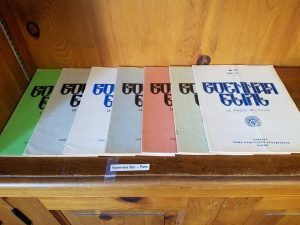

















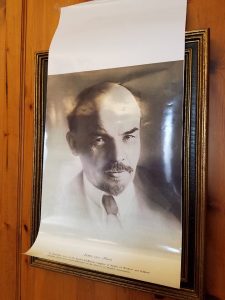

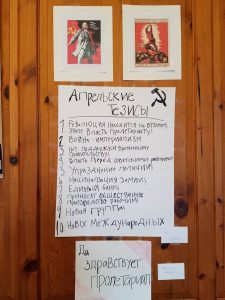
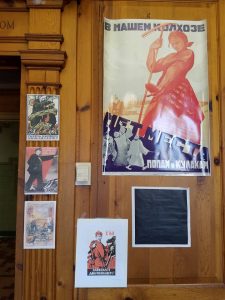


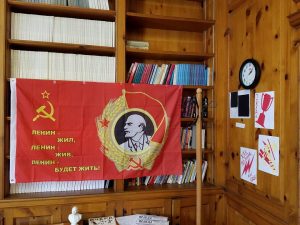
Émigré Propaganda Room
By Cameron Devitt
The first stage of putting together any type of propaganda, advertisement, or persuasive material is first understanding your audience and the argument you want to make. In crafting our emigré propaganda room we determined our target audience would be the emigré population in France as the image presented to us of the Gallipoli Society in class suggested. Then, we thought about the historical platform of the emigrés during the Russian Revolution. They aimed to restore the old order by crushing the Bolsheviks and their Red Army and freeing the Tsar. Thus, one could say that our argument was that through our propaganda room we hoped to persuade individuals of the cultural superiority of the old Russian history as well as convince them that the white army and our cause was still powerful with potential for success. Accordingly, we hoped they would be more likely to support the cause as they had in history.
Since the monarchy was symbolic of Russia’s old history, it became a vital symbol to the white army’s platform and propaganda. To blatantly emphasize this, an incredibly large photograph of Tsar Nicholas II in the middle of the propaganda room reminded viewers that to escape the chaos and insecurity with Bolshevism, they needed to restore order as it was. Likewise, a Double-Headed Eagle coat of arms used by the royal family suggested the deep Russian history that was being destroyed. Finally, the Russian flag was symbolic of the historical Russian spirit. When looking though sources to put in the room in special collections, it was interesting to see the extent to which the monarchy played such an extravagant but large role of the people’s lives and for me it reawakened the sense of urgency the émigrés must have felt to restore order amidst chaos.
Equally important propaganda to the emigré cause was white army propaganda. Because the white army quickly became the more decentralized of the two armies, it was important to convince people that there was still hope for the possibility of returning to a secure country. Thus, portraits of Anton Denekin, Alexander Kolchak, Pyotr Nikolayevich Wrangel, and Nikolai Yudenich were meant to reassure the emigrés of their strong leaders. Likewise, pamphlets such as Who Is Denekin? and Who is Kolchak? were available if people wanted to learn more about these leaders and their backgrounds. In addition, pictures such as the Nurses of Kornilov’s Army (1918), the Group of Kornilovtsy (“Followers of Kornilov”), and the pictures of Colonial Schleglov (part of Kornilov’s Army) and General Bazaravich (a military agent in Serbia) served to remind émigrés of the network of people supporting their cause and acted as propaganda showing that the white army was doing well. The designers of the propaganda room in Paris understood the importance of maintaining hope and positivity among the émigrés for continued support and in our replica we tried to do the same.
In the same vein, communication was very important. Since the émigrés were not living in Russia where they could walk out their door to purchase a newspaper about the daily events, they created their own newspapers such as Voennaia Byl., “La Sentinelle,” and Posledniye Novosti which presumably they may have had access to in propaganda rooms. Either way, these newspapers were powerful in keeping the émigrés informed and their goals coherent. White poetry, like red poetry was also key in evoking feelings towards the revolution. Poetry has the ability to connect with people on an emotional level and keeping people attached to the white cause was vital. Thus, we included a white poetry book in the propaganda room and two white propaganda posters suggesting the importance of the white cause.
In creating this propaganda room, I think we reignited the spirit, the tension, and the chaos of the Russian Revolution. I can only imagine the challenges that must have come with trying to manage an army outside of the country you are fighting in with the lack of accessible communication. Despite their ultimate failure, their dedication to the cause is evident through the poems we read and the newspapers published. It must’ve been extremely frustrating to work so hard at protecting an old Russian spirit that so essential to your prior life experiences and yet see it slowly crumble at the expense of the “newness” of the Bolshevik socialist experiment.
Mark Steinberg, in the conclusion of his The Russian Revolution, suggests a theme about the revolution in the present that has helped me to best understand why the propaganda room project was significant to my learning and self-growth. He writes,
It is not the work of the historian to predict the future- the past’s futures are hard enough to predict. Yet, somehow in our times we see a remarkable number of people across the world, mostly young, acting as if they believe that one must venture beyond the limits of life as it is to create life as it ought to be…These dreamers challenge all they judge to be negative in the world…and, not least, resist what we tell them is impossible to achieve. (356)
To me, creating this propaganda room was an act of empathy. By forcing me to act as an émigré in the time of the Russian Revolution, I was able to gain insight into the emotional connection all Russians had to the revolution, but especially the connections of those abroad. As someone who is fascinated by entrepreneurial spirit, I admire the ownership the large proportion of Russian’s took in trying to help create their own destiny in this time of disorder as evident in the newspapers and poems. They “resisted” the “impossible” and took a stance. I believe this stance speaks to both their brilliance and lack of identity; brilliance in the action they took and failure in their ability to recognize that radical change has only the slimmest change of long-term success in its first trial. Of course, this failure is understandable due to the oppression they faced and looking at the Russian Revolution through the lens of a first year college student has made me all the more grateful for the emphasis my high school English courses put on exploring self-identity. Thus, the most valuable opportunity the creation of this room gave me was a chance to connect and think more deeply about the spirit of the ordinary actors of the Revolution. While learning about Lenin and Kolchak and Stalin is and Denikin is vital to the context of the revolution, as someone who is still trying to discover and mature the future path of my life, it is neat to look at the 1917-1921 actors and see how their stories are remarkably different, yet remarkably similar to my own. Although I’d never hope to experience the brutality of the Russian Revolution, there is something to be said all of these people trying to find their voice in the wake of freedom to try and make an impact. After all, as John Green said, “What is the point of living if you don’t at least try to do something remarkable?”
Recreating a Soviet Space
By Jacob Bruggeman
In the opening pages of his new book, The Russian Revolution: 1905-1921, Mark Steinberg writes: “I want to imagine we can walk through the streets during the ‘springtime of freedom’ [of 1917]: go to the demonstrations and meetings, listen to speeches, talk with people in public […] Above all, I want to imagine we can ask people what they meant by that […] idea that everyone insisted defined the revolution: ‘freedom’.”[1] I would posit that Steinberg’s most recent addition to the historiography succeeds in painting for readers a better picture of the past; yet, for all Steinberg’s efforts, is it always impossible for people of the present to fully understand events from a century ago. Steinberg’s history of the Russian Revolution, like all histories, provides a series of lenses through which we see a recreation of the past fashioned from its sources or “traces,” if you will. A different way of understanding the past is to act it out, to attempt to place oneself in the mindset of our far-back-in-time forerunners; to engage the past by recreating it, not through abstractions in prose, but through informed actions. Through creating our Propaganda Room for class, we engaged with the past in an all-to-often rejected vehicle for learning history: hands-on activities. In so doing, my group—that is, the group representing the Bolsheviks—was forced to grapple with the sense of authorship, newfound freedom, and utter uncertainty felt by Bolsheviks in 1917.
The Propaganda Room was split down the middle to allow for both Bolshevik and anti-Bolshevik propaganda rooms, or half-rooms, to be constructed. Our side of the room had many moving parts: there was a banner, posters, Suprematist artwork, excerpts from literature, mass-produced pamphlets, a portrait of Lenin and flag dedicated to his everlasting life, and countless reproductions of Bolshevik propaganda cartons and images (one perk of being on the “right side of history” is an abundance of sources to work with). Stripped of their independent historical contexts, each piece of propaganda in the room carried is own historical gravity, informed by the histories we have explored through class, and its own emotional aura, moving viewers in ways unique to their understanding, or lack thereof, of what we have learned. The room, then, was a sort of amalgam of Bolshevik propaganda, each piece plucked from different places, different points throughout the “springtime of freedom,” and different individuals’ imaginations of what was to come for Russia. As such, our half of the Propaganda Room lacked the cogency and coherency of a museum exhibit; however, in my view, this was for the better.
As Steinberg notes in his book, Walter Benjamin observed that human history contains the possibility “of a ‘springtime’,” and that revolutions, when they occur, are one of humanity’s “strongest expressions of […] desire, vision, and possibility.”[2] I see an interesting alignment between our Propaganda Room project and Steinberg’s argument about the Russian Revolution: as noted earlier, our construction of the Propaganda Room reflects our effort to engage the past through acting it out, yet, in acting as Bolshevik revolutionaries, we felt no compulsion to order our room in any particular fashion; therefore, we voiced “desire[s]” and “vision[s]” for the room with an anarchistic disregard for the contemporary conventions of presenting traces of the past as is done in museums. Instead, we built our Propaganda Room with a random blend of artifacts and artwork, signifying a reconceptualization of time, which, as Steinberg suggests, often results from revolution. Indeed, the unpredictability with which we picked traces of the past for presentation the Propaganda Room speaks to the how, as Steinberg points out, “revolutions “blast open the continuum of history” […] and allow humanity to “leap in the open air of history,”” thereby transforming history into “radical possibility.”[3]
In a world of “radical possibility” the only impossibility can be a singularity of meaning, and so it would be hard to argue that our Propaganda Room had a single thrust, for there were many meanings which could be drawn from the disparate races of the past in the room. As mentioned earlier, many of our traces of the past came from very different contexts, and so they can be said to have different purposes. On one wooden panel, we posted two poems by Vladimir Mayakovsky, and these works represented the Russian Symbolists’ eschatological vision of “the dreary, rationalistic, thoroughly corrupt world […] [being] swept away by a destructive, “purifying” fire”;[4] yet directly under these poems were piece of propaganda calling upon Russian to engage with industry, and therefore maintain—at least to some extent—the time’s industrial order. The divergent meanings of our traces of the past resulted in each panel, or even each piece on each panel, having its own atmosphere of meaning, its own thrust of propagandizing. Furthermore, a piece of Suprematist art I made, which sat to the panel at the right of the Mayakovsky poems, depicted the sense of dissimilar meanings in the Russian Revolution through triangles colliding with one another, and so, in another odd parallel, may even reflect heady theory interpretation of the room. In this way, the room mimics the cacophony of voices during the Russian Revolution, each with their own “desire[s]” and “vision[s],” and thus demonstrates the utility of learning history through a physical engagement with it.
[1] Steinberg, Mark D. The Russian Revolution, 1905-1921. Oxford, United Kingdom: Oxford UP, 2017. Print. Pg. 15.
[2] Steinberg, Mark D. The Russian Revolution, 1905-1921. Oxford, United Kingdom: Oxford UP, 2017. Print. Pg. 17.
[3] Steinberg, Mark D. The Russian Revolution, 1905-1921. Oxford, United Kingdom: Oxford UP, 2017. Print. Pg. 17
[4] Dralyuk, Boris. 1917: Stories and Poems from the Russian Revolution. London: Pushkin, 2016. Print. Pg. 50.